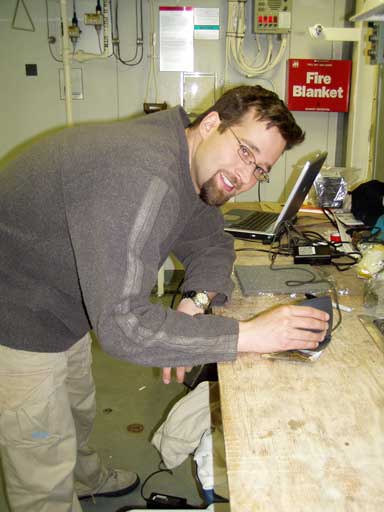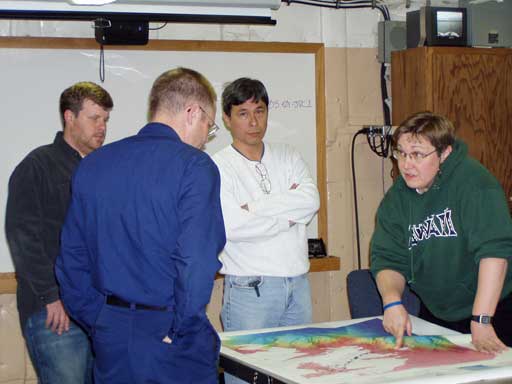( Log In ) Log In is for TREC Teachers & Researchers only
  |
| Steve_Marshall |
 Jun 24 2005, 03:11 PM Jun 24 2005, 03:11 PM
Post
#1
|
 TREC Teacher    Group: TREC Team Posts: 78 Joined: 27-April 05 Member No.: 12 |
Wednesday 6/22/05
THE WORK GOES ON Considering we collected or 5th and 6th piston cores today, along with another multi-core and several plankton tows, it’s hard to imagine that just a few days ago I was wondering if we were going to have enough time after getting freed from the ice to collect anything! During some of our work today, we were met with something new…Snow! While it was only some light flurries from time to time, it was still something of a novelty since there has generally been bright sunshine for most of this cruise. Not having much time to ponder this rare snow, I went back to the normal routine of helping out where I could, taking pictures, and working on journal entries. The piston cores, multicore, and plankton tows were all successful for the most part today, so it seems things have finally gotten into a steady, successful rhythm. In addition to all the work associated with the cores, multi-cores, and plankton tows that I have described previously, I took some time to look around for new things to write about. One such thing was the reflectance studies done on the multi-cores by Joseph Ortiz and Guillaume St-Onge. Another basic part of experimentation is reproducibility of results and repetition or comparison of results. Related to this, Ortiz and St-Onge both had equipment that measured the reflectance or color characteristics of the sediments. To test the accuracy, similarity, and precision of the instruments, Joe and Guillaume decided to analyze the same material with their two different instruments. After doing this, they decided the results were similar, but that Joe had equipment which could produce more precise information. We decided that was a good thing since Joe’s equipment was so much more expensive! I guess for some things, you really DO get what you pay for. Comparing Results  Joe Ortiz (left) and Guillaume St-Onge (right) look at the reflectance data taken from a multi-core sample to see if the results from their two different instruments provide similar information Analyzing the Sample  Guillaume is shown here scanning a sample with an instrument that analyzes the color of core sediment While Joe and Guillaume were working on there research, Leonid was looking through a microscope at sediment and foraminifera found in one of the multi-core samples. Since I had taken a picture of Leonid earlier in our cruise of him looking through a microscope without any samples because he was just testing the equipment, I thought it would be fitting to take some more pictures of him actually looking at something! Getting a Close View  Leonid Polyak looks through a microscope at some sediments taken from a multi-core sample. Zooming In  A close-up picture of the microscope sample and Leonid using a brush to move the sediments around to ensure all can be viewed Expert Extruders by Now  Since so much research is based on analyzing the multi-cores, Glenn Berger (left) and Guillaume’s (right) job of extruding the core samples has become invaluable. Considering this is the 3rd multi-core, with at least 6 tubes on each multi-core, Glenn and Guillaume have had lots of practice too! During a break in the lab work, we had a science meeting after dinner. We discussed the status of our sample collections so far, and planned our agenda for the last few days of the cruise. While the cruise has seemed long in some ways, and short in others, already talking about winding up our work and check-out procedures seems to make the end of the cruise come up faster than you’d expect. There wasn’t much time to dwell on that, because soon after the meeting, we went back to work. Discussing the Plan  Some members of the science team are shown here discussing the plan for the remainder of the cruise Working with the Captain  Members of the mapping crew from the University of Hawaii, who have also been analyzing the seismic data to help choose good coring locations, discuss the best location for the next coring site with Captain Oliver (facing away from the camera). Facing the camera are Paul Johnson (left), Steven Tottori (middle), and Margo Edwards (right). This time, it was the plankton tow that we were doing. Since I tend to stay up late anyway, I agreed when asked to help out with this operation (we started around 10 pm). My main responsibility was to record our position and the time that the net reached the depths it was to be raised and lowered to. Although I wasn’t doing every step of the procedure, just being that close to the operation allowed me to observe all the procedures in more detail than I could when I was at a distance taking pictures. Another thing to note about helping out with this was that it was the first time I’ve felt really COLD on this trip. Although it had stopped snowing, it was still foggy and damp. I usually wore two pair of socks when working outside, but I had forgotten to do that this time. I’m not sure if my feet will forgive me Waiting for the Numbers  Picture of me recording the location and time data for the plankton tow Plankton-filled Samples  Water samples, filled with plankton, that were taken from the four plankton tows made at this location Smile for the Camera!  It was hard to get the camera to focus properly, but if you look hard enough, I think you can see some of the plankton, especially near the upper right edge of the container We finally completed the plankton tows at around 12:30 am, and I went back inside the ship soon after to warm my feet and work a little on my journal entries before going to bed for a few hours of sleep before having to wake up and start all over again. |
  |
1 User(s) are reading this topic (1 Guests and 0 Anonymous Users)
0 Members:

|
NSF Acknowledgment & Disclaimer | Time is now: 16th November 2024 - 09:05 AM |
Invision Power Board
v2.1.7 © 2024 IPS, Inc.








